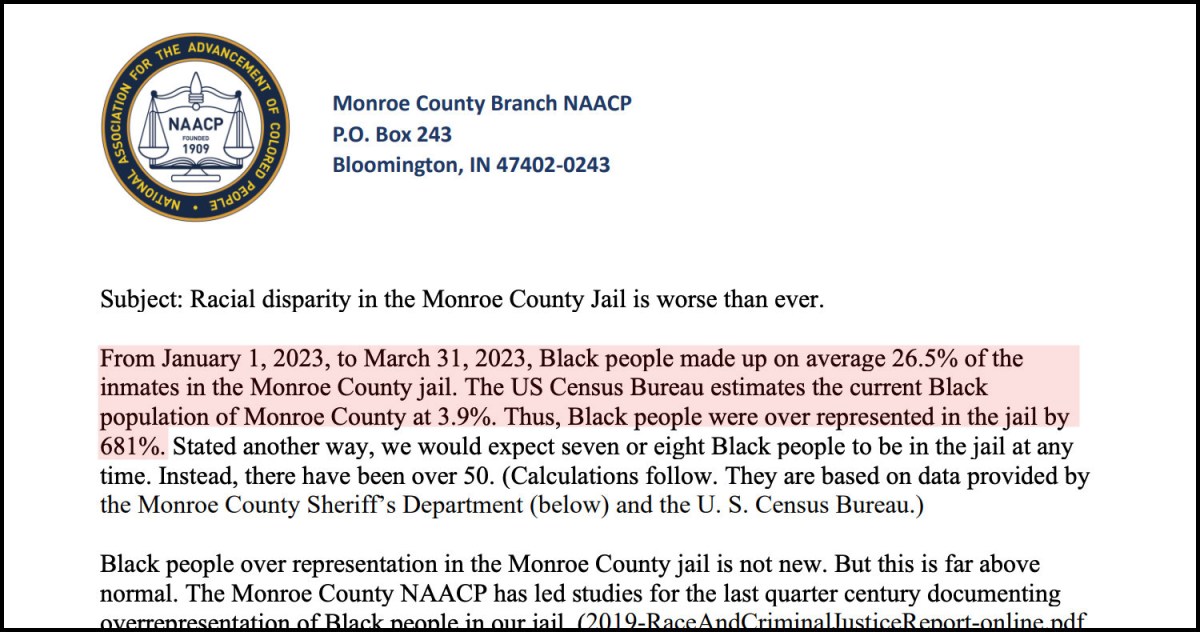
Diversity, equity, and inclusion was the focus of Monday afternoon’s meeting of the county council’s justice fiscal advisory committee (JFAC).
The highlight of the committee’s meeting was a presentation on racial disparity at the Monroe County jail. Presenting the information was former attorney Guy Loftman, who serves on the legal redress committee of the Monroe County Branch of the NAACP.
A key fact presented by Loftman, based on Monroe County jail statistics from earlier this year, was the disparity between the percentage of Black inmates and the percentage of Black residents of Monroe County.
As measured by the U.S. Census in 2020 about 3.9 percent of Monroe County residents are Black. But for the 3-month period between Jan. 1 and March 31 of this year, Black people made up on average 26.5% of the inmates in the Monroe County jail.
JFAC’s Monday meeting was the first of three meetings this week when local officials will have criminal justice-related matters on their agenda.
On Friday at noon, Bloomington’s city council has a work session scheduled, to hear from county officials about options for locating a new county jail.
Appearing on Tuesday’s regular monthly meeting for the full county council is a discussion item about “potential adjustments to the LIT-special purpose fund rate.” That’s a juvenile detention-related tax.
Special purpose (juvenile detention) local income tax rate
The county’s special purpose local income tax (LIT), which is collected at a rate of 0.0518 percent, is currently restricted under state statute to funding “the operation and maintenance of a juvenile detention center and other facilities to provide juvenile services.” In 2023, the special purpose tax is supposed to generate about $3.9 million.
One idea would not be to raise the rate of the special purpose tax, but rather to reduce it, say by 0.01 points, and to replace that rate with a new rate of 0.01 points in the corrections category of local income tax. Revenue in the corrections category could be spent on the current jail facility.
It’s an idea that was floated by county councilor Marty Hawk at the council’s July 25 work session. That approach would keep the overall rate of taxation the same.
Why bother changing the rate, if it doesn’t raise or lower revenue overall? It’s worth considering, because the special purpose tax is routinely generating more money every year than Monroe County juvenile services is spending.
Based on a B Square review of fund balances since 2011, for the last five years, the special purpose income tax has generated an average of $818,000 more each year than has been spent. The fund’s year-end balance for 2022 was about $5.4 million.
Jail location: City council?
A Friday noon work session of Bloomington’s city council is supposed to be an occasion for councilmembers to hear from county officials about their efforts to find a suitable location for a new jail.
Still on the list of sites being considered by the county government is the new Hopewell neighborhood. That’s despite an apparent lack of any interest on the part of Bloomington mayor John Hamilton’s administration in trying to locate a jail facility in Hopewell. That’s the site of the former IU Health hospital facility at 2nd and Rogers streets.
A glimmer of hope for county officials might be found in some remarks delivered by Bloomington city councilmember Steve Volan earlier this year at the council’s Feb. 15 meeting. He began his remarks with criticism of the mayor and the three county commissioners (Julie Thomas, Penny Githens, and Lee Jones).
Unfortunately, with all due respect to both offices, the mayor is as stubborn as the commissioners. There’s very good little goodwill between their mutual offices. I think the technical term to describe all four of them is stubborn cusses. They’ve been unable to come to terms, for example, on plans for using the food and beverage tax to expand the convention center.
Volan then described a “grand bargain” that involved an allocation of three acres, from the roughly 24 acres of the Hopewell neighborhood area, for construction of a new county jail.
I think that a grand bargain is in order. The administration needs to offer up at least three acres to the county and use it to negotiate for an understanding on the convention center. There’s no reason why we can’t come to a deal. But it requires personal diplomacy, not just from people like us, but from the mayor and the commissioners themselves. The time for bickering has to end.
In late 2022, the city council denied the requested rezone of a parcel in the south part of town, which county officials had targeted as a jail location. Since then, county officials have had a consultant review four possible locations—including the Hopewell site, the county-owned Thomson PUD south of Catalent, and two other locations somewhere in the I-69 corridor.
JFAC: Diversity, equity, inclusion
The idea of focussing on important decisions like the location of the jail came up during Monday’s JFAC meeting.
From Ruth Aydt at the public mic came an admonition of sorts: “I want to challenge you to think about the location of the jail. Who is that going to impact? What neighborhood is that going to be in?”
Aydt continued, “When you think about who to fund, are you funding agencies or employees who are respectful of everyone, regardless of race, gender, ethnicity? I think that sets the stage for a lot.”
Aydt was reacting in part to the prominent theme of data collection, which had emerged during the JFAC meeting. She had worked with Loftman to analyze the racial disparity numbers. So she was not at all against the use of data. But she cautioned against the role that data collection can play in delaying any forward movement.
Aydt put it like this: “I do think that data can be very valuable. I also think that we can see it for years and years and years and years and not make any change.” She continued, “I’m very concerned that that’s a safe topic. ‘Let’s collect more data. Let’s look for data. Let’s see what we need to do.’ And it prevents forward movement. So I would challenge you to think about that.”
Data had become a big theme of the JFAC meeting after Loftman’s presentation, which showed racial disparity in Monroe County’s jail. That led to calls from committee members during the meeting for better data collection and accessibility.
Loftman’s presentation on Monday included the fresh numbers from this spring, which showed a racial disparity at Monroe County’s jail—about seven times the number of Black inmates as would be expected from a random sampling of Monroe County’s overall population.
That’s worse even than the pattern 25 years ago, Loftman said.
Based on previous work, Loftman said, stops that were initiated by law enforcement officers were not predominantly against Black people. Instead, the officer-initiated stops were predominantly against white people, Loftman said. He analyzed that as stemming from the sheer number of white college students who are arrested for alcohol-related offenses.
Where the racial disparity showed itself, Loftman said, was the number of Black people who were in jail for failure to appear in court and for violation of probation. Loftman put it like this: “In other words, most people were coming into jail not because they committed new crimes, but because they couldn’t get along with the criminal justice system.”
The importance of collecting and sharing data was a big theme of Monday’s JFAC meeting. County councilor Peter Iversen pointed to the criticism in a consultant’s report delivered two years ago—the one that concluded that the Monroe County jail is currently failing to provide constitutional levels of care.
In that report, the available of data on criminal justice matters in Monroe County is described like this:
There is a distinct lack of easily available data to consistently measure and evaluate the effectiveness and efficiency of court and jail operations and practices. For existing data, there is no centralized database or data repository containing salient data from the courts, law enforcement, jail, prosecution, defense, and community corrections agencies to fully and accurately evaluate system practices and outcomes.
At Monday’s JFAC meeting, Julie Hardesty, who serves on Monroe County Women’s Commission, pointed to a lack of data on gender—because the only options in the forms to be filled out are male and female. Hardesty also noted that the percentage of inmates who identify as female is increasing. In 2018, about 25 percent of the inmates in the Monroe County jail identified as female, she said. But Hardesty noted that the numbers were old.
Towards the end of Monday’s JFAC session, the meeting chair, county councilor Jennifer Crossley, pushed for a focus on the specific kind of data that committee members think is important, in order to make progress.
Deputy county prosecutor April Wilson responded to Crossley by saying it’s important to understand why someone is in jail. The length of time someone has been in jail is a data point, but it matters whether they are being held on an attempted murder or murder charge compared to a misdemeanor, Wilson said.
Someone who has multiple OWI offenses, Wilson said, might wind up going out and killing someone, if they’re drinking. The data points have to be fleshed out, Wilson said.
The next meeting of the JFAC is set for Aug. 28.
This post was originally published on this site be sure to check out more of their content.







